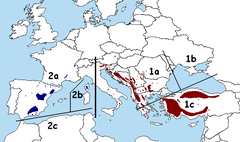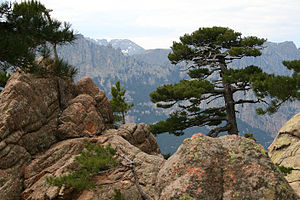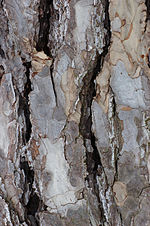- Pinus nigra
-
European Black Pine
Pinus nigra
Pinus nigra subsp. nigra, Bulgaria Conservation status Scientific classification Kingdom: Plantae Division: Pinophyta Class: Pinopsida Order: Pinales Family: Pinaceae Genus: Pinus Subgenus: Pinus Species: P. nigra Binomial name Pinus nigra
J.F.Arnold
Distribution Pinus nigra, the European Black Pine, is a moderately variable species of pine, occurring across southern Mediterranean Europe from Spain to the Crimea, in Asia Minor and on Cyprus, and in the high mountains of the Maghreb in North Africa.
Contents
Distribution
Pinus nigra is a tree of the Mediterranean forests, woodlands, and scrub biome. The majority of the range is in Turkey. It is found in the higher elevations of the South Apennine mixed montane forests ecoregion in southern Italy and the Tyrrhenian-Adriatic sclerophyllous and mixed forests ecoregion in Sicily. There are remnant populations in the Mediterranean conifer and mixed forests ecoregion, and in the higher Atlas Mountains in Morocco and Algeria.
It is found at elevations ranging from sea level to 2,000 metres (6,600 ft), most commonly from 250–1,600 metres (820–5,200 ft). Several of the varieties have distinct English names.[2]
Description
Pinus nigra is a large evergreen tree, growing to 20–55 metres (66–180 ft) tall at maturity. The bark is grey to yellow-brown, and is widely split by flaking fissures into scaly plates, becoming increasingly fissured with age. The leaves ("needles") are in thinner and more flexible in western populations (see 'Taxonomy' section below).
The ovulate and pollen cones appear from May to June. The mature seed cones are 5–10 cm (rarely to 11 cm) long, with rounded scales; they ripen from green to pale grey-buff or yellow-buff in September to November, about 18 months after pollination. The seeds are dark grey, 6–8 mm long, with a yellow-buff wing 20–25 mm long; they are wind-dispersed when the cones open from December to April. Sexual maturity is reached at 15–40 years; large seed crops are produced at 2–5 year intervals.
Pinus nigra is moderately fast growing, at about 30–70 centimetres (12–28 in) per year. It usually has a rounded conic form, that becomes irregular with age. The tree can be long lived, with some trees over 500 years old. It needs full sun to grow well, is intolerant of shade, and is resistant to snow and ice damage.
Taxonomy
The species is divided into two subspecies, each further subdivided into three varieties.[3][4] Some authorities (e.g. Flora Europaea) treat several of the varieties at subspecific rank, but this reflects tradition rather than sound taxonomy, as the distinctions between the taxa are small.[5]
- Subspecies
- Pinus nigra subsp. nigra in the east of the range, from Austria, northeast and central Italy, east to the Crimea and Turkey. Needles stout, rigid, 1.5–2 mm diameter, with 3–6 layers of thick-walled hypodermal cells.
- Pinus nigra subsp. nigra var. nigra (syn. Pinus nigra var. austriaca, Pinus nigra subsp. dalmatica) Austrian Pine. Austria, Balkan Peninsula (except southern Greece).
- Pinus nigra subsp. nigra var. caramanica Turkish Black Pine. Turkey, Cyprus, southern Greece.
- Pinus nigra subsp. nigra var. pallasiana (syn. Pinus nigra subsp. pallasiana) Crimean Pine. Crimea.
- Pinus nigra subsp. salzmannii in the west of the range, from south Italy to south France, Spain and north Africa. Needles slender, more flexible, 0.8–1.5 mm diameter, with 1–2 layers of thin-walled hypodermal cells.
- Pinus nigra subsp. salzmannii var. salzmannii Pyreneean Pine. in the Pyrenees and southern France, northern Spain.
- Pinus nigra subsp. salzmannii var. corsicana (syn. Pinus nigra subsp. laricio, Pinus nigra var. maritima) Corsican Pine. Corsica, Sicily, southern Italy.
- Pinus nigra subsp. salzmannii var. mauretanica Atlas Mountains Black Pine. Morocco, Algeria.
Ecology
 Trees of Pinus nigra var. corsicana—Corsican Pine, in Corsica.
Trees of Pinus nigra var. corsicana—Corsican Pine, in Corsica.
 Pinus nigra var. corsicana—Corsican Pine plantation, in Belgium.
Pinus nigra var. corsicana—Corsican Pine plantation, in Belgium.
In Mediterranean Europe and Asia Minor—Western Asia trees usually associated with this species include Scots Pine (Pinus sylvestris), Serbian Spruce (Picea omorika), Bosnian Pine (Pinus heldreichii), Norway Spruce (Picea abies), Lebanon Cedar (Cedrus libani), European Silver Fir (Abies alba) and related firs. Several species of juniper (Juniperus spp.), and various broadleaf trees are associates.
- Climate and provenance
The eastern Pinus nigra subsp. nigra exhibits greater winter frost hardiness (hardy to below −30°C) than the western Pinus nigra subsp. salzmannii (hardy to about −25°C).[3]
Different provenances (seed sources by geographic area) or varieties are adapted to different soil types: Austrian and Pyrenees origins grow well on a wide range of soil types, Corsican origins grows poorly on limestone, while Turkish and Crimean origins grow well on limestone. Most provenances also show good growth on podzolic soils.
Cultivation
Lumber
The European Black Pine wood is similar to that of Scots Pine (Pinus sylvestris) and Red Pine (Pine resinosa), being moderately hard and straight-grained. It does however tend to be rougher, softer, and not as strong, due to its faster growth. It is used for general construction, fuel, and in paper manufacture.
In the United Kingdom, Pinus nigra is important both as a timber tree in plantations (primarily Corsican Pine subsp.). Recently however, serious problems have occurred with red band needle blight disease, caused by the fungus Dothistroma septosporum, resulting in a major recent decline in forestry planting there. [6] In the United States it is of low importance as a timber species.
Ornamental tree
In the United States European Black Pine is planted as a street tree, and as an ornamental tree in gardens and parks. Its value as a street tree is largely due to its resistance to salt spray (from road deicing salt) and various industrial pollutants (including ozone), and its intermediate drought tolerance. In the United Kingdom the tree is planted as an ornamental tree in parks. In both the United States and United Kingdom most of the European Black Pines planted are from Austrian sources, the Pinus nigra subsp. nigra and Pinus nigra subsp. nigra var. nigra seed selections.
Pinus nigra is planted for windbreaks and shelterbelts in the U.S., recommended for windbreaks in the Northern Great Plains on medium to deep moist or upland soils.
- Invasive species
Pinus nigra has become naturalised in a few areas of the United States. In New Zealand it is considered an invasive species and noxious weed, along with Lodgepole Pine—Pinus contorta and Scots Pine—Pinus sylvestris, due to their habitat conversion nature in tussock grassland plant communities, shading out the native bunch grasses as their forest canopy develops.
See also
- Index: Mediterranean forests, woodlands, and scrub Biome
- Index: Flora of the Mediterranean
References
- ^ Conifer Specialist Group (1998). Pinus nigra. 2006. IUCN Red List of Threatened Species. IUCN 2006. www.iucnredlist.org. Retrieved on 12 May 2006.
- ^ Rushforth, K. (1987). Conifers. Helm ISBN 0-7470-2801-X.
- ^ a b Gymnosperm Database: Pinus nigra
- ^ Christensen, K. I. (1993). Comments on the earliest validly published varietal name for the Corsican Pine. Taxon 42: 649-653.
- ^ Farjon, A. (2005). Pines Drawings and Descriptions of the Genus Pinus 2nd ed. Brill ISBN 90-04-13916-8.
- ^ Forestry Commission: Red band needle blight
External links
 Media related to Pinus nigra at Wikimedia Commons Categories:
Media related to Pinus nigra at Wikimedia Commons Categories:- IUCN Red List least concern species
- Pinus
- Flora of the Mediterranean
- Flora of Western Asia
- Flora of Albania
- Flora of Algeria
- Flora of Bosnia and Herzegovina
- Flora of Austria
- Flora of Corsica
- Flora of Croatia
- Flora of Cyprus
- Flora of France
- Flora of Greece
- Flora of Italy
- Flora of Kosovo
- Flora of Macedonia
- Flora of Morocco
- Flora of Serbia
- Flora of Slovenia
- Flora of Spain
- Flora of Turkey
- Invasive plant species in New Zealand
- Trees of Mediterranean climate
- Trees of mild maritime climate
- Garden plants of Africa
- Garden plants of Asia
- Garden plants of Europe
- Ornamental trees
- Least concern plants
Wikimedia Foundation. 2010.



